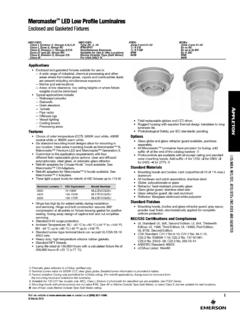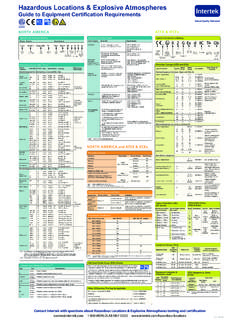Transcription of Tech Note Definitions of Classes, Groups and …
1 Tech Note Definitions of classes , Groups and Divisions Hazardous Locations: Definitions of classes , Groups and Divisions Hazardous locations are areas where the potential for fires or explosions exists because of gases, dust, or easily ignitable fibers or particles in the atmosphere. In North America, hazardous areas are separated by classes , Groups and divisions to define the level of safety required for equipment installed in these locations. classes define the general form of the flammable materials in the atmosphere. Groups classify the exact flammable nature of the material. Divisions define the probability of the presence of flammable materials. SUMMARY OF CLASS I, II, and III HAZARDOUS LOCATIONS. classes Groups DIVISIONS. 1 2. A. Acetylene Not normally present B. Hydrogen, etc. I Gasses, Vapors in an explosive C. Ether, Etc. Normally explosive and Liquids (Art. concentration (but D. Hydrocarbons, Fuels, and hazardous 501) may accidentally Solvents, etc.)
2 Exist.). E. Metal Dusts (conductive and explosive). Ignitable quantities Dust not normally F. Carbon Dusts (Some of dust that is suspended in an are conductive* and normally or may be, ignitable concentration II Dusts (Art. 502) all are explosive). in suspension or (but may accidentally G. Flour, Starch, Grain, conductive dust may exist). Dust layers are Combustible Plastic or be present. present. Chemical Dust (explosive). H. Textiles, Woodworking, etc. Stored or handled in III Fibers and (easily ignitable, but Handled or used in storage (exclusive of Flyings (Art. 503) not likely to be manufacturing. manufacturing). explosive). *NOTE: Electrically conductive dusts are dusts with a resistivity less than 105 OHM-centimeter. 1. Tech Note Definitions of classes , Groups and Divisions In Europe and countries outside of North America, classification of hazardous locations is accomplished differently. The International Electrotechnical Commission (IEC) uses a series of zones rather than classes and divisions to classify hazardous areas.
3 The table below compares the classifications to the equivalent IEC/EU and CA/CEC classifications. AREA CLASSIFICATION (Comparison of IEC/EU, US and CA). Flammable Flammable Material Flammable Material Material Present Present Intermittently Present Abnormally Continuously IEC/EU Zone 0 Zone 1 Zone 2. NEC 505 Zone 0 Zone 1 Zone 2. NEC 500. Division 1 Division 2. CA CEC. Section 18 Zone 0 Zone 1 Zone 2. CEC Annex J. Division 1 Division 2. IEC classification per IEC 60079-10. EU classification per EN 60079-10. US classification per ANSI/NF PA 70 National Electrical Code (NEC ) Article 500 or Article 505. CA Classification per CSA Canadian Electrical Code (CEC) Section 18 or Annex J. APPARATUS GROUPING. US (NEC 505). CA (CEC Section 18). EU US (NEC 500). Typical Gas IEC CA (CEC Annex J). Acetylene group IIC Class I/ group A. Hydrogen ( group IIB + H2) Class I/ group B. Ethylene group IIB Class I/ group C. Propane group IIA Class I/ group D.
4 Methane group I* Mining*. *Not within scope of NEC . Under jurisdiction of MSHA. Not within scope of CEC. 2. Tech Note Definitions of classes , Groups and Divisions INGRESS PROTECTION (IP) CODES. First Characteristic Numeral Second Characteristic Numeral Protection Against Solid Bodies Protection Against Liquid 0 No protection No protection 1 Objects greater than 50 mm Vertical (90 ) dripping water 2 Objects greater than 12 mm 75 to 90 dripping water 3 Objects greater than mm Sprayed water 4 Objects greater than 1 mm Splashed water 5 Dust-protected Water jets 6 Dust-tight Heavy seas 7 Effects of immersion 8 Indefinite immersion Approximate Enclosure Type (NEMA) Equivalent to IPXX. Type IP Type IP Type IP. 1 10 3S 54 6 and 6P 67. 2 11 4 and 4X 55 12 and 12K 52. 3 54 5 52 13 54. 3R 14. 3. Tech Note Definitions of classes , Groups and Divisions Common Classifications Some classifications are not shown here. For further detailed information, see specific standards published by approval organizations.
5 Class I, Division 1. Class I, Division 2. Class I, Zone 0. Class I, Zone 1. Class II, Division 1. Class II, Division 2. Class III, Division 1. Class III, Division 2. Class I, Division 1. A Class I, Division 1 location is a location where ignitable concentrations of flammable gases, vapors or liquids: can exist under normal operating conditions;. may exist frequently because of repair or maintenance operations or because of leakage; or may exist because of equipment breakdown that simultaneously causes the equipment to become a source of ignition. Equipment intended for use in a Class I, Division 1 area is usually of the explosion-proof, intrinsically safe, or purged/pressurized type. Below is a definition of each of these types: Explosion-proof apparatus "Apparatus enclosed in a case that is capable of withstanding an explosion of a specified gas or vapor that may occur within it and of preventing the ignition of a specified gas or vapor surrounding the enclosure by sparks, flashes, or explosion of the gas or vapor within and that operates at such an external temperature that a surrounding flammable atmosphere will not be ignited thereby.
6 " (See NFPA 70). Intrinsically safe apparatus "Apparatus in which all the circuits are intrinsically safe." (See UL 913). Intrinsically safe circuit "A circuit in which any spark or thermal effect is incapable of causing ignition of a mixture of flammable or combustible material in air under prescribed test conditions." (See UL 913). 4. Tech Note Definitions of classes , Groups and Divisions Purging "The process of supplying an enclosure with a protective gas at a sufficient flow and positive pressure to reduce the concentration of any flammable gas or vapor initially present to an acceptable level." (See NFPA 496). Pressurization "The process of supplying an enclosure with a protective gas with or without continuous flow at sufficient pressure to prevent the entrance of a flammable gas or vapor, a combustible dust, or an ignitable fiber." (See NFPA 496). Class I, Division 2. A Class I, Division 2 location is a location: where volatile flammable liquids or flammable gases or vapors exist, but are normally confined within closed containers.
7 Where ignitable concentrations of gases, vapors or liquids are normally prevented by positive mechanical ventilation; or adjacent to a Class I, Division 1 location, where ignitable concentrations might be occasionally communicated. Equipment intended for use in a Class I, Division 2 area is usually of the nonincendive, non-sparking, purged/pressurized, hermetically sealed, or sealed device type. Nonincendive circuit "A circuit in which any arc or thermal effect produced under intended operating conditions of the equipment is not capable, under the test conditions specified, of igniting the specified flammable gas- or vapor- air mixture."(See UL 1604). Nonincendive component "A component having contacts for making or breaking an incendive circuit and the contacting mechanism shall be constructed so that the component is incapable of igniting the specified flammable gas- or vapor-air mixture. The housing of a nonincendive component is not intended to: exclude the flammable atmosphere, or contain an explosion.
8 " (See UL 1604). Nonincendive field circuit "A circuit that enters or leaves the equipment enclosure and that under intended operating conditions is not capable, under the test conditions specified, of igniting the specified flammable gas- or vapor-air mixture or combustible dust." (See UL 1604). 5. Tech Note Definitions of classes , Groups and Divisions Non-sparking apparatus "Apparatus that has no normally arcing parts or thermal effects capable of ignition. Examples of normally arcing parts are relays, circuit breakers, servo-potentiometers adjustable resistors, switches, non-latching type connectors and motor brushes. (See UL 1604). Purging See definition under Class I, Division 1. Pressurization See definition under Class I, Division 1. Hermetically sealed component "A component that is sealed against entrance of an external atmosphere and in which the seal is made by fusion, such as soldering, brazing, welding, or the fusion of glass to metal.
9 " (See UL 1604). Sealed device "A device that is constructed so that it cannot be opened, has no external operating mechanisms, and is sealed to restrict entry of an external atmosphere without relying on gaskets. The device may contain arcing parts or internal hot surfaces." (See UL. 1604). Class I, Zone 0. A Class I, Zone 0 location is a location where ignitable concentrations of flammable gases, vapors or liquids: are present continuously; or are present for long periods of time. Equipment intended for use in a Class I, Zone 0 area is usually of the intrinsically safe, "ia," type. Intrinsically safe See Definitions under Class I, Division 1. 6. Tech Note Definitions of classes , Groups and Divisions Class I, Zone 1. A Class I, Zone 1 location is a location where ignitable concentrations of flammable gases, vapors or liquids: are likely to exist under normal operating conditions;. may exist frequently because of repair or maintenance operations or leakage.
10 Or may exist because of equipment breakdown that simultaneously causes the equipment to become a source of ignition; or are adjacent to a Class I, Zone 0 location from which ignitable concentrations could be communicated. Equipment intended for use in a Class I, Zone 1 area is usually of the flameproof, purged/pressurized, oil immersed, increased safety, encapsulated or powder filled type. Flameproof "The enclosure of the equipment will withstand an internal explosion, and prevent passage of flame to the surrounding atmosphere. Care must be taken to maintain the length and clearance (gap) of flameproof joints in service." (See UL 2279). Purged/pressurized See Definitions under Class I, Division I. Oil immersion "Arcing contacts are immersed in a protective liquid." (See UL 2279). Increased safety "The equipment contains no normally arcing parts, and additional measures (such as larger spacings among wiring connections) are taken to prevent the possibility of high temperatures or sparks.






